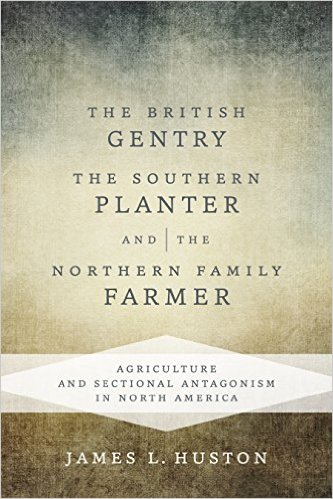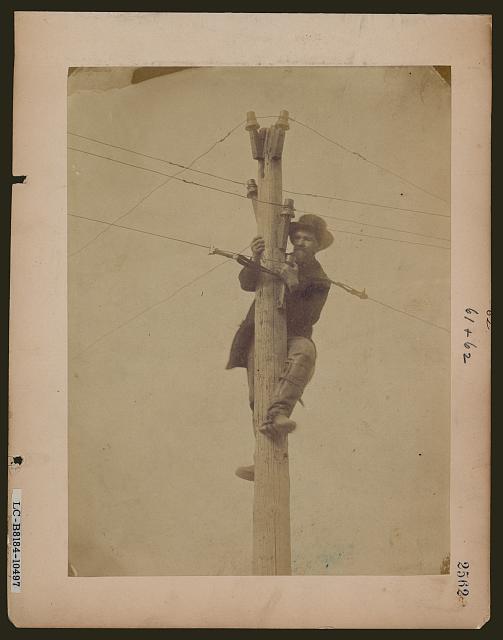The British Gentry, The Southern Planter, and the Northern Family Farmer: Agriculture and Sectional Antagonism in North America by James L. Huston. Louisiana State University Press, 2015. Cloth, IBSN: 978-0807159187. $47.50.
 The intersection between politics and economics in the late antebellum era has long intrigued James Huston. His first book examined the political consequences of a sharp economic contraction in 1857. It showed that Republicans gained the upper hand in pivotal Pennsylvania by blaming the Democratic Party and the incumbent president, James Buchanan, for the state’s depressed coal and iron economy. More recently, his Calculating the Value of the Union broadly sketched the economic origins of the Civil War, in which the South demanded—and the North rejected—nationwide property rights in slaves.
The intersection between politics and economics in the late antebellum era has long intrigued James Huston. His first book examined the political consequences of a sharp economic contraction in 1857. It showed that Republicans gained the upper hand in pivotal Pennsylvania by blaming the Democratic Party and the incumbent president, James Buchanan, for the state’s depressed coal and iron economy. More recently, his Calculating the Value of the Union broadly sketched the economic origins of the Civil War, in which the South demanded—and the North rejected—nationwide property rights in slaves.
Here Huston widens his lens, both spatially and temporally. Systems of labor and landholding in early modern England and the Old South were, he asserts, broadly similar. Large estates or plantations gobbled up land, squeezed out self-sufficient yeomen, and dictated that most work be done by those who had no chance to own land or to control their own lives. Southern and British ruling classes set themselves apart, rationalized that physical labor was not genteel, and demanded “the mastery of some people over others” (207).
By contrast, farm families in the free states worked unremittingly to gain a “competency.” The Northern free labor system prized independence and self-mastery. Farm size was limited by the numbers of laborers in a single family. An abundance of modest-sized farms created more dense patterns of settlement than in the South, facilitated networks of mutual support, and spurred the growth of small towns that serviced a rural-based economy. Northern farms provided primarily for family well-being rather than for profit; by contrast, the South’s plantations and British estates were “engines of wealth and income accumulation” (158).
Huston rejects the idea that a pre-modern South confronted a modern industrial North. This sets him against an array of historians—Charles and Mary Beard, Eugene Genovese, and James McPherson, among others. He also faults social historians such as Christopher Clark, who find in the North’s free labor ideology a barely-disguised rationale for “wage slavery” and “industrial capitalism” (185).
Huston’s bracing, wide-angled overview of North-South economic differences deserves respectful consideration, but the ground on which he attempts to stand will remain contested. Scholars such as McPherson will continue to depict a more modern free-state economy and the relative absence of a home market in the slave South. The most dynamic sectors of the Northern rural economy did attempt to break the labor constraints of family farming by employing newly developed machinery (notably reapers) and by taking advantage of new transportation technologies (railroads) that facilitated sales to distant markets.
Huston also claims that his economic model provides a silver bullet to explain the coming of the Civil War. But here—at least in the judgment of this reviewer—he overreaches. He contends that the South’s “voracious appetite for land” created a deadly competition to control regions that had been reserved for family farms (239). Huston eagerly seconds Abraham Lincoln’s warning that a slave power conspiracy threatened to impose the plantation system on Kansas and soon would try to legalize it in Illinois and other free states.
But controversies about landed expansion can scarcely carry all the weight Huston assigns to them. His readers would not guess, for example, that antislavery Northerners gravitated to territorial restriction because the Constitution precluded any frontal assault on slavery in the states where it already existed. At stake here was a symbol of national policy at least as much as a disagreement about the agricultural potential of western territories. Kansas actually offered little to slaveowning migrants, who had every incentive to head instead for the Lower Mississippi valley or East Texas, where slave-based labor was far more profitable. Most of Kansas and Nebraska also proved too arid for modest rain-based family farms that Northern migrants craved. Yet Huston demands that the catastrophic collision between the North and the South resulted because both sides insisted on barring the other from the West.
Huston shortchanges the cultural and ethnoreligious elements that shaped the new Republican Party. His blunt generalization, that the Republican base was “rural and agricultural, not urban and industrial,” obscures as much as it illuminates (xii). Family farms indeed were broadly typical throughout the free states—and also in yeoman-dominated parts of the Upper South. But yeomen did not gravitate en masse to the Republican Party. Instead, it most attracted New Englanders and those who migrated west from New England. They transformed northeastern Ohio’s Western Reserve and a broad swath of counties in northern Illinois into standout Republican citadels. But the farmers in central and southern Ohio, Indiana, and Illinois whose families originated in the upland South kept their distance from the party of Lincoln. Many Maine and New Hampshire farmers who had been Democrats certainly did switch to become Republicans in the mid-1850s, but Democratic allegiances continued to dominate the three rural counties of northwestern New Jersey where Yankees were few and far between. New Englanders also, as McPherson notes, pioneered new technologies.
Huston has surprisingly little to say in this book about the actual political context within which the 1854-61 crisis unfolded (he has written extensively in other venues about politics, most recently in a strong 2011 essay in The Journal of the Civil War Era). But here he too cavalierly dismisses historians Michael Holt and Edward Ayers, who think the North-South political breakdown involved much hyperbole and exaggeration as Northern Republicans warned about a slave power conspiracy, Southern Democrats smeared Republicans as allies of John Brown, and both sides saw themselves acting defensively to counter hostile external forces.
On balance, Huston’s argument is rigid and deterministic. Marc Egnal’s Clash of Extremes: The Economic Origins of the Civil War explores the material underpinnings of North-South antagonism with more nuance and with greater skepticism about “abstract, disembodied Larger Forces.” Egnal charts the rise of a northwestern Great Lakes economy in regions that attracted New Englanders and soon became the Republican Party’s antislavery heartland. At the same time, zealots in parts of the Lower South insisted that Southern rights required new territories for slavery. Unlike Huston, Egnal depicts a sectional knot tied by passionate minorities both North and South—so that bewildered majorities only polarized once the fighting started.
Ultimately, nobody can square secession and war with the rational pursuit of economic interest. Republicans who voted for Lincoln did not expect to trigger a war. Lower South secessionists blindly cut short all hope of territorial expansion. Most of all, when white Southerners, like lemmings, fatally plunged over the cliff, they did not know that they were about to bring their cherished slave system to a screeching halt.
Daniel W. Crofts, Professor Emeritus of History at The College of New Jersey, is the author of Lincoln and the Politics of Slavery: The Other Thirteenth Amendment and the Struggle to Save the Union, to be published in Spring 2016 by the University of North Carolina Press.
